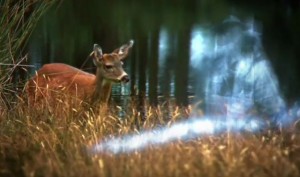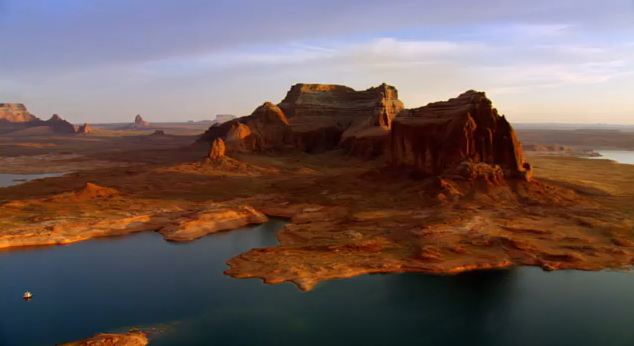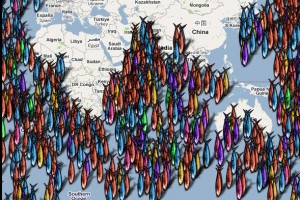Paul Snelgrove: Making Ocean Life Count
“How inappropriate to call this planet Earth when it is quite clearly Ocean.”
— Arthur C. Clark
The world’s first comprehensive Census of Marine Life — past, present, and future — was released in 2010 in London, at the same time that Paul Snelgrove released his book: Discoveries of the Census of Marine Life: Making Ocean Life Count.
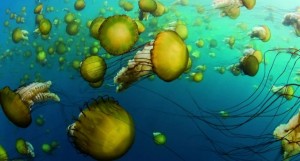 The Census of Marine Life was started by two scientists who realised that the Oceans were in trouble and we were doing nothing about it.
The Census of Marine Life was started by two scientists who realised that the Oceans were in trouble and we were doing nothing about it.
Planet Ocean
Although the oceans cover some 70% of our planet, providing more habitat than all other habitat combined, and produce about half of the new life everyday on earth as well as about half of the oxygen that we breathe, we know more about the surface of the Moon and about Mars than we do about the oceans
The Census project was undertaken by a global network of 2700 scientists from more than 80 nations who engaged in a 10-year scientific initiative assess and explain the diversity, distribution, and abundance of life in the global ocean.
The three main components of the census were organised around the questions:
What has lived in the oceans?
What does live in the oceans?
What will live in the oceans?
They wanted to construct the history of marine animal populations since human predation became important – roughly the last 500 years. The Roman development of salting fish as a means of preservation changed fishing patterns from one of purely catching “the meal for the day” to industrial scale fishing.
New Technologies
The study examined and used new technologies to explore unknown species and habitats, migration routes and distribution patterns, how the oceans are changing and what we can expect from them in the future.
New technologies facilitated research, remotely operated vehicles combined with satellite communication enabled distant scientists to participate in scientific investigations thousands of miles away, and the new science of genetic bar coding , developed by geneticists enabled the exact recognition of fish species.
Results have been quite astounding, with 4-5 new species from the ocean being described each day. The information has proved extremely valuable already in many ways, for example, scientists in the Gulf of Mexico had just taken a census of species in the gulf which proved very useful when the Gulf Oil Spill happened , to establish a clear idea of how marine life in the area had been affected.
Paul Snelgrove gives a fascinating talk supported by illuminating graphics and astounding photographs.
Read MoreGreat Laws of Nature: Rediscovering Health
The United Nations has declared 2012 the “Year of the Co-operative”
to celebrate and encourage the successful work being done
across the globe by co-operatives of all kinds.
One very inspiring story of co-operation comes from the heart of Canada via a video which explores the work being done through a Co-operative in Saskatchewan by a group of First Nations People who are reconnecting with Nature, learning and observing her natural laws, and getting back on the road to self-reliance.
Out of Nothing, the Creator made Rock, Water, Fire and Wind.
From these four substances He created the physical world of the Sun ..Stars, moon and earth. Then He made the plant species.
“What we have to do is we have to study Nature. Nature is the greatest teacher if you take time, and listen.”
William Ermine, Saskatchewan Elder explains: “Nature lives in harmony with itself, each looks out for the other, each protects the other. There is no warring, there is no gossip, there is nothing. They live in harmony side by side, they are not fighting over that piece of land that they grow from. That is organic, as designed by our Creator.”
To Each a Spirit of Life, Growth, Healing and Beauty
There are four kinds of plant beings – flowers, grasses, trees and vegetables. To each, the Creator gave a spirit of Life, Growth, Healing and Beauty. Each He placed where it would be most beneficial, and lend to Earth the greatest Beauty, Harmony and Order”
Daniel Musqua continues: “It’s a belief that everything has Life and everything has Spirit. We pray to these Plant Spirits. These Spirits were put here on this Earth to look after all living things. They are at work in the Universe, here.” Daniel, a First Nation Elder is also a 3rd Generation Organic Farmer.
“Everything here has a purpose in its natural state, and it’s that purpose that we have to try to emulate within that relationship with these plants. There are people believe all life is connected, you certainly hear from the mainstream society it’s good to talk to your plants, and that’s taken quite seriously by the First Nations.”
After plants, the Creator made Animal Beings, conferring on each, special powers.
Last, he made Man, the Keepers of the Earth.
The Great Laws of Nature
Written and Directed by Noah Erenberg
Edited by Bruce Little
Many thanks to Director Noah Erenberg for making this great documentary,
presented here courtesy of Muskoday Organic Growers Co-op Ltd.
If you want to purchase a copy of this video
please contact the producers through this link:
rivard@rivard.tv
Muscoday Organics on Facebook
“We will take care of you, we will deal with your enemies, the other weeds and the other competitors, and in turn, you can feed us and take care of us at some point.
Read MoreCitarum River: the Pollution of Paradise
Once a peaceful waterway rich in fish and waterside wildlife, where local villagers caught fish and used its waters to irrigate rice paddies, the Citarum River in West Java in Indonesia is a living (or dying) example of how much damage humans seem to be willing to cause to their environment.
Today it has the reputation of being one of the most polluted river in the world, and villagers who can no longer catch fish in it, pick through the pollution that carpets it, to try to earn a living.
25 million people in western Java rely on the river for drinking water and irrigation as the Citarum River traverses its 269 kilometers, passing through nine regencies and three cities. Of the 25 million people who depend on the river, 10 million live along its banks, split more or less evenly between urban and rural residents
Pollution to the river escalated with the rapid industrialisation of this area in the 1980’s, but many factories had been pouring toxic waste into its waters for generations before that.
One of the companies polluting the river,the Chisso Corporation’s chemical factory dumped industrial wastewater containing methyl mercury, into the river from 1932 to 1968. Toxins built up in fish which were a mainstay of the local diet.
The damaging effects on humans from rivers polluted by heavy metals can sometimes take years to manifest. Symptoms include numbness in hands and feet, general muscle weakness, narrowing of the field of vision and damage to hearing and speech.
In some cases insanity, paralysis, coma and death follow within weeks of the onset of symptoms.
“By March 2001, 2,265 victims had been officially recognized with 1,784 fatalities,and over 10,000 receiving financial compensation from the company. By 2004, the company had paid US$86 million in compensation, and in the same year was ordered to clean up its contamination.”
— one of the disturbing elements of the above story taken from the Jackarta Post, is that the company appears to have only been told to clean up its act in 2004 after paying out millions in compensation and after more than 70 years of poisoning the river.
Read MoreHome: Do You Know Where You Live?
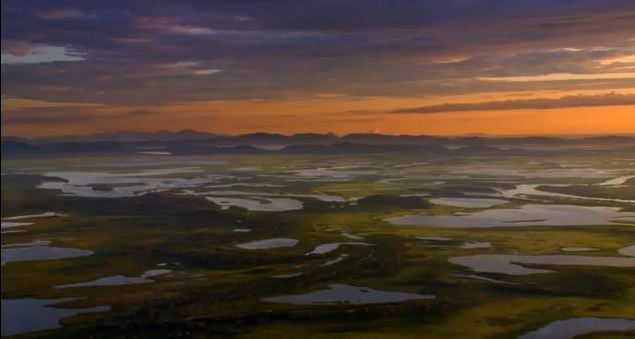 The first time I became aware of the unique project being undertaken by photographer Yann Arthus-Bertrand was when I unexpectedly stumbled across his “Earth from the Air” exhibition outside the Science Museum in London a few years ago.
The first time I became aware of the unique project being undertaken by photographer Yann Arthus-Bertrand was when I unexpectedly stumbled across his “Earth from the Air” exhibition outside the Science Museum in London a few years ago.
Like the other people walking between the giant photographs, I was quite awe-stuck by the experience.
The images were pin-sharp powerful unique statements, wondefully composed and in many cases looking for all the world like beautiful abstract paintings. There were some of the most beautiful landscapes I had ever seen, while other images could quite easily have been details of the human body seen through an electron microscope (like mother, like child?).
They were all aspects of the surface of the planet taken from the air.
The film is simply and appropriately called “Home”
It is one of the most important films ever released, and certainly one of the most visually impressive. The earth is given a voice in images, allowed to describe herself to us, simply by sharing some portraits of who she is. We are all children of the earth, this astoundingly beautiful being that deserves our love, respect and care.
This classic film that took so many years to create has been given as a gift to all the people of the planet by its creator, Yann Athus-Bertrand and with the support of its sponsors it has been released totally free to the public.
It is free – you are encouraged to share it, and the organisation will even help you to arrange public screenings of it, because the message it carries is so important.
It is yours – watch it, and then share it with someone else.
Home, a film by Yann Arthus-Bertrand – click the link to view it
A Message from the Photographer
“We are living in exceptional times. Scientists tell us that we have 10 years to change the way we live, avert the depletion of natural resources and the catastrophic evolution of the Earth’s climate.
The stakes are high for us and our children. Everyone should take part in the effort, and HOME has been conceived to take a message of mobilization out to every human being.
For this purpose, HOME needs to be free. A patron, the PPR Group, made this possible. EuropaCorp, the distributor, also pledged not to make any profit because Home is a non-profit film.
HOME has been made for you : share it! And act for the planet.”
Yann Arthus-Bertrand, GoodPlanet Fundation President
Read More(Sign Up and Claim ) Your Piece of the Ocean
Seven tenths of Earth is covered by water and the oceans belong to all of us.
Every individual on Earth has a right to assume that the oceans are managed for the benefit of all those alive, their children and grandchildren – not on behalf of vested interests. If the biological diversity of the oceans is to be maintained or restored, large areas must be protected altogether from the commercial fishing industry and responsible fishing must prevail outside those areas.
Every person on the planet can claim 2 hectares of ocean – that’s what you get if you divide the surface area of ocean by the number of people on Earth.
If the biological diversity of the oceans is to be maintained or restored, large areas must be protected altogether from the commercial fishing industry and responsible fishing must prevail outside those areas.
With some help from our friends at Google, we have created the map you can see here. Anyone willing to pledge their support to the campaign can lay claim to their 2 hectares.
Pledge your support and claim your piece of the ocean here…
Read More

